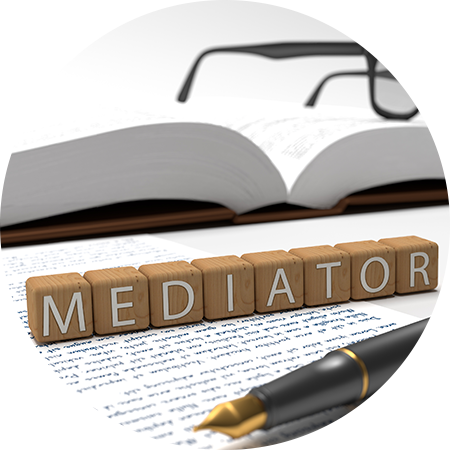We’re here to Help You and Your Family
We understand this is a difficult time for many families and we strive to reduce the amount of unnecessary stress.
We offer a variety of process options so that you can find the right fit to meet the needs of you and your family. Please contact us if you have questions or would like to receive further information about any of the processes described below.
What is Litigation/ Negotiation?
Litigation is the process of filing a legal claim with the Courts which sets out the relief that you are claiming. After following the steps in the litigation process, the dispute is eventually heard and determined by the Court if not resolved through negotiations in advance.

How does Litigation/ Negotiation work?
In litigation, you hire a lawyer to provide legal advice and represent your interests in out of court negotiations and court hearings. Communication occurs primarily through lawyers, with the lawyers making proposals, counter-proposals, and defending the position taken, usually in writing with letters going back and forth and possibly through the attendance at settlement meetings. If attendances in court are necessary, your lawyer will prepare the required court documents and attend in court to present and argue your position in Court. You will then be bound by the decision of the Justice hearing your matter.
What is the Litigation Process: Step-by-step?
- Step #1: Preparing and filing a claim
- You and your lawyer work together to determine and outline the relief that you wish to seek, such as division of matrimonial property, a claim relating to the children, a claim for child support, and/or a claim for spousal support.
- The relief sought is set out in a Statement of Claim or Family Law Claim that is filed with the courthouse and served on the opposing party.
- Step #2: Gathering relevant information
- It is necessary for you and your lawyer to gather relevant financial and other information relating to your family’s assets, debts and income. This can be accomplished in a number of ways, including:
- The voluntary exchange of relevant information between you and your spouse.
- Filing a Notice to Disclose/Application, which requires you to exchange financial information with your spouse within a certain period of time, failing which the matter is heard in court and orders may be made requiring the provision of financial disclosure.
- Attending at Questioning, which is a process in which each of you and your spouse are questioned by the other’s lawyer under oath and the information that is gathered is used as sworn evidence in further proceedings.
- It is necessary for you and your lawyer to gather relevant financial and other information relating to your family’s assets, debts and income. This can be accomplished in a number of ways, including:
- Step #3: Resolving the matters in issue
- There are a number of options in the litigation process which can be used to resolve the matters in issue between you and your spouse/partner. These include:
- Negotiations
- Communications/settlement proposals exchanged in writing between the lawyers
- Four-way settlement meetings
- Meetings involving both lawyers and both parties where settlement options are canvassed
- Judicial Dispute Resolution
- The lawyers and both parties attend before a Justice where the Justice assists the parties in resolving their dispute
- Interim Court Applications
- Attendance before a Justice at the courthouse for interim relief (meaning a temporary solution to a problem – such as a temporary order outlining an interim parenting plan).
- Trial
- Attendance before a Justice at the courthouse for final relief (meaning a final decision on any matters in dispute between the parties).
- Negotiations
- There are a number of options in the litigation process which can be used to resolve the matters in issue between you and your spouse/partner. These include:
What is the process for Interim Court Applications?
Interim Court Applications are heard in either Regular Chambers or Special Chambers.
In Regular Chambers, matters are only allowed to take 20 minutes of the Justice’s time. Regular Chambers is meant for simple matters or matters with urgency that need to be heard as soon as possible. An Application and supporting Affidavit is filed by the initiating party. The responding party has the opportunity to file an Affidavit in response, and potentially a Cross-Application. An Affidavit is a sworn statement outlining the relevant facts in the matter and attaching any relevant documents. The Justice hearing the matter does not have the opportunity to review the materials filed by each party in advance of hearing the application in Chambers. The Justice makes a decision after hearing from the lawyers for each party. You and your spouse do not give oral evidence – your evidence is confined to your Affidavits.
Special Chambers involves matters that are expected to take longer than 20 minutes of the Justice’s time and are more complex. The process of filing Applications and Affidavits is the same as for Regular Chambers except that there are certain filing deadlines that occur long before the application is heard. In addition, each lawyer is able to prepare a letter outlining their client’s position and legal arguments in support. The Justice hearing the matter has the opportunity to review and consider the materials filed by each party in advance of hearing the application.
What is a trial?
A trial is a process where witnesses are called to give oral evidence before the Justice hearing the matter. Each witness is cross-examined by the opposing lawyer. The Justice is able to assess the credibility of each witness and make a final determination relating to all matters in dispute.
What are some key things to know?
- While the litigation process is a formal process utilizing the court system, it is important to understand that settlement still remains the primary objective. It is always better to attempt to reach a mutually agreeable resolution outside of court than to put your fate in the hands of someone else (i.e. the Justice hearing your dispute).
- As there are deadlines inherent in the litigation process, use of the litigation process may be a helpful way to move matters forward where one party is less motivated to reach a resolution.
- There are limitation periods that, if they expire, will prevent you from advancing certain claims. In addition, once a claim is initiated there are rules about long delay which may prevent a claim from being continued if it has stagnated for a long period of time. It is important to receive timely legal advice to prevent these limitations problems from happening to you.
At Symmetry Family Law, our lawyers are skilled litigators and have experience at all levels of the Alberta Courts.
Mediation
Mediation is a non-adversarial, cooperative decision-making process in which a neutral third party, the mediator, assists you and your spouse in resolving your legal issues by agreement.

Who can use Mediation?
- Couples going through a divorce or separation
- Divorced or separated couples needing to resolve post-divorce/separation issues that arise relating to parenting, child support or spousal support
- Common law couples or adult interdependent partners who are separating
- Couples wanting to develop a Prenuptial, Postnuptial or Cohabitation Agreements
Role of the Mediator:
The mediator acts as a neutral facilitator and does not act as an advocate for either you or your spouse. The mediator guides you to a resolution. You and your spouse are in control of the process and the outcome. You will seek outside legal counsel for legal advice.
The Mediation Process:
- Step 1: Intake
- You and/or your spouse contact Symmetry Family Law to complete the client intake process
- Step 2: Initial Meeting
- You and your spouse attend together for an initial meeting with your Symmetry Family Law mediator to:
- Discuss confidentiality
- Discuss fees
- Discuss the exchange of relevant information
- Sign the Agreement to Mediate
- You and your spouse attend together for an initial meeting with your Symmetry Family Law mediator to:
- Step 3: Series of Meetings with Mediator:
- Discuss goals and interests
- Explore issues
- Gather and exchange relevant documentation
- Identify and consider options and alternatives
- Reach a mutually agreeable resolution
- Step 4: Draft Mediation Report:
- Your mediator prepares a draft mediation report detailing the agreement reached
- Each of you and your spouse review the draft with an independent lawyer before it is finalized
- Step 5: Final Mediation Report / Separation Agreement
- Your mediator prepares a final mediation report for signature and a Separation Agreement
- You and your spouse attend with an independent lawyer for Independent Legal Advice (ILA) and to sign the Separation Agreement
Cost of Mediation:
Mediation is typically a cost-effective process option as your resources are focused on reaching a resolution through a cooperative process. In addition, you are paying one professional, rather than two separate lawyers, which provides some costs savings. You do, however, each require your own lawyer to provide independent legal advice when signing the final Separation Agreement.
Contact our office today to obtain more information and to book the mediation intake appointment.
Collaborative Family Law
Collaborative Family Law (CFL) is an out-of-court process that enables you and your spouse to create your own settlement with the support of a team of highly trained professionals. You and your spouse each hire a specially trained, registered Collaborative Family Lawyer, and potentially other Collaborative Family Professionals, such as mental health professionals and financial specialists, if beneficial to your family’s unique situation. All of these professionals work together in a cooperative, non-adversarial manner to achieve a lasting, mutually agreeable settlement.
The collaborative approach relies on an interdisciplinary team who work together to assist you and your spouse to achieve a common purpose. The team can involve as few or as many team members as your family needs. Simple matters will not likely require a full team approach whereas a full team will be useful if there is a complex financial situation or a higher level of conflict. Overall, you and your spouse are the most important members of the team. You retain control over your lives and the lives of your children. You have the opportunity to work out creative and practical solutions to your problems.
Collaborative Divorce Alberta Association
Collaborative Divorce Edmonton has provided a helpful document outlining the Collaborative Divorce process

How is CFL different from negotiation in litigation?
Your collaborative lawyer functions as a settlement specialist rather than an adversarial advocate. Using a negotiation technique called interest-based negotiation, your collaborative lawyer will help you and your spouse understand each others interests, needs and goals and work together to come to an agreement that you are both satisfied with. By contrast, your lawyer in a litigation model is typically engaged in positional bargaining, which is adversarial by its very nature.
What are the benefits of the Collaborative process?
- A goal towards resolution
- You have assurance that both lawyers will be working towards reaching a resolution acceptable to all outside of the Court process
- A team of specially trained professionals is available
- Lawyers
- Mental health professionals:
- Family Specialists
- Divorce coaches
- Financial Specialists
- Chartered Accountants
- Chartered Business Valuators
- Financial Advisors
- Mortgage Brokers
- A healthier environment for children
- The process is designed to minimize conflict and support the needs of the children
- Flexibility
- Options are not limited to the rigid formulas which may characterize traditional negotiations or court-imposed outcomes
- Control
- You and your spouse maintain control of the process and the eventual outcome
- You will not face a binding decision imposed by a Court
- Privacy
- Resolution occurs in a series of private meetings
- Financial documents need not be filed in Court
- Potential cost savings:
- Your resources are solely focused on activities that advance resolution
Steps in Collaborative Family Law:
- Step #1: You and your spouse each retain a registered Collaborative Family Lawyer
- Step #2: You and your spouse sign the Participation Agreement
- Step #3: You and your spouse exchange complete financial disclosure
- Step #4: You, your spouse and the collaborative lawyers (along with any additional team members needed) attend a series of face to face meetings. The meetings are focused on generating options for resolution and coming to a creative, mutually agreeable resolution on all issues.
- Step #5: The lawyers prepare a legally enforceable agreement and provide the requisite independent legal advice. Joint divorce documents may be prepared upon request.
Contact Symmetry Family Law today to obtain more information about Collaborative Family Law and to book an initial consultation.
Binding Parenting Resolutions
A binding resolution is a method of having parenting disagreements or parenting issues resolved in a timely and cost-effective manner without the need for Court. The disagreement or issue is resolved by an experienced family lawyer acting as a neutral decision-maker.

How Does a Binding Resolution Work?
- You and your spouse or ex-spouse attend at Symmetry Family Law. You may attend with or without a lawyer.
- You speak directly to the Arbitrator, who is a lawyer acting as the decision-maker about your parenting issue.
- The Arbitrator is instead a neutral decision-maker.
- The Arbitrator will have over 10 years of experience working as a family lawyer.
- The Arbitrator will hear from both you and your spouse and will read any documents or written materials that are submitted, by agreement, prior to the hearing.
- The Arbitrator will issue a written decision with brief reasons, called an “Arbitration Award” that is an enforceable decision, similar to a Court Order.
What Types of Parenting Issues are Appropriate for Binding Resolutions?
- Requests to travel with the children;
- Vacation/holiday schedules;
- Minor parenting schedule changes that do not significantly impact on each parent’s overall time with the children;
- Enrolment in extracurricular activities;
- Schooling or education decisions;
- Classification of section 7 expenses;
- Decisions regarding medical providers or therapists for the children; and
- Any other issues that the Arbitrator deems suitable for Binding Resolution.
What are the steps involved in a Binding Resolution?
- Step 1: Both you and your spouse/ex-spouse fill out an intake form and provide it to Symmetry Family Law. The intake form can be obtained by contacting Symmetry Family Law. The intake form identifies the following:
- Will you be attending with or without lawyers?
- Will you provide legal documents (Affidavits) or non-legal documents?
- What are the issues to be determined?
- Is a Court Order required?
- Step 2: The intake forms are reviewed by and it is determined if the matter is appropriate for Binding Resolution. If appropriate, then both of you and your spouse are emailed an Arbitration Agreement to sign and return as well as are advised of the required fee/time allotment. The Arbitration Agreement is what gives the lawyer the authority to make the parenting decision.
- Step 3: Upon receiving a completed Intake Form from each spouse, the signed Arbitration Agreement, and the retainer fee, instructions will be provided to book a hearing date and time.
- Step 4: Once the hearing date is booked, you will be provided with deadlines for the exchange of legal or non-legal documents, depending on the option selected.
- Step 5: The Arbitrator reads the materials provided prior to the hearing date.
- Step 6: The hearing is held. You will need to give an oath to tell the truth or give a solemn affirmation to tell the truth. The hearing will be recorded. You and your spouse will be provided with equal time to present information to the Arbitrator.
- Step 7: The Arbitration Award (decision) is sent to both you and your spouse via email within three business days after the hearing with abbreviated reasons for the decision. If a Court Order is required, a draft Court Order will be provided at the same time for you or your lawyers to enter by consent in Court.
- Step 8: There is a right to appeal the decision to the Court in accordance with the Arbitration Act (Alberta).
How Much Does a Binding Resolution Typically Cost?
- 1-hour hearing: $1500.00 plus GST*
- 2-hour hearing: $2000.00 plus GST*
Includes: Review of written materials or Affidavit in advance of hearing, attendance at hearing, preparation and delivery of the Arbitration Award, and preparation of a draft Consent Order (if required).
(*If unanticipated issues arise, additional fees may be charged based on the time spent on such additional issues. These will be discussed in advance if they arise).
For more information regarding Binding Resolutions or to receive the Intake Form to complete and return to our office so that you may receive a fee estimate, please contact Symmetry Family Law.
